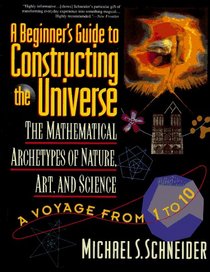Kayote B. (kayote) reviewed A Beginner's Guide to Constructing the Universe: Mathematical Archetypes of Nature, Art, and Science on + 254 more book reviews
This is a great idea. Unfortunately, it reads like a college freshman report. Looked up lots of things, threw them together, not always sure of what they mean but sound good, and run through own world filter heavily. For example "the ancients" did this and that. That's a lot of cultures lumped together, and it would be better if more specific. Author clearly more familiar with Greek and Egyptian, because those are most commonly directly referenced. When he talks about any others, (such as Native Americans--who are at one point explicitly all lumped together as being one organized group, though I think he was trying to talk about the Iroquois) it gets..questionable. The art sometimes is clearly based on the geometry it's overlaid with and others...um...yeah, that's stretching. Some art is used repeatedly with different geometric figures, and it certainly fits some better than others. But it's all within us if we just reunite with the cosmos we will know everything.
Too much of the book is "yeah, that's stretching" and "WHICH ancients? All of them? That needs a lot more proof" and "say what?".
And quibbling, the offhand comment that humans have 8 openings. I'm not even sure how to count to get that, and I'm absolutely certain that the number of openings is different between men and women--which is not mentioned in his text going on about how glorious that number is. Similarly 8 is said to be the only number that is a multiple of 3 others (1,2,4)....except so is 6 (1,2,3) which he pointed out in an earlier chapter. So something is missing or skipped there.
There's some fascinating stuff in this book. There is a lot of slogging to find it. Also, I would double check facts before relying on them. There seems a lot thrown in that "sounded good" but some of it I know is not quite right and makes me question a lot of it. Like I said, a freshman writing a report who isn't yet entirely good at getting context for facts or putting them together or editing.
He does have a lot of details on how to do geometric constructions. So the book is good at showing you that.
Too much of the book is "yeah, that's stretching" and "WHICH ancients? All of them? That needs a lot more proof" and "say what?".
And quibbling, the offhand comment that humans have 8 openings. I'm not even sure how to count to get that, and I'm absolutely certain that the number of openings is different between men and women--which is not mentioned in his text going on about how glorious that number is. Similarly 8 is said to be the only number that is a multiple of 3 others (1,2,4)....except so is 6 (1,2,3) which he pointed out in an earlier chapter. So something is missing or skipped there.
There's some fascinating stuff in this book. There is a lot of slogging to find it. Also, I would double check facts before relying on them. There seems a lot thrown in that "sounded good" but some of it I know is not quite right and makes me question a lot of it. Like I said, a freshman writing a report who isn't yet entirely good at getting context for facts or putting them together or editing.
He does have a lot of details on how to do geometric constructions. So the book is good at showing you that.




